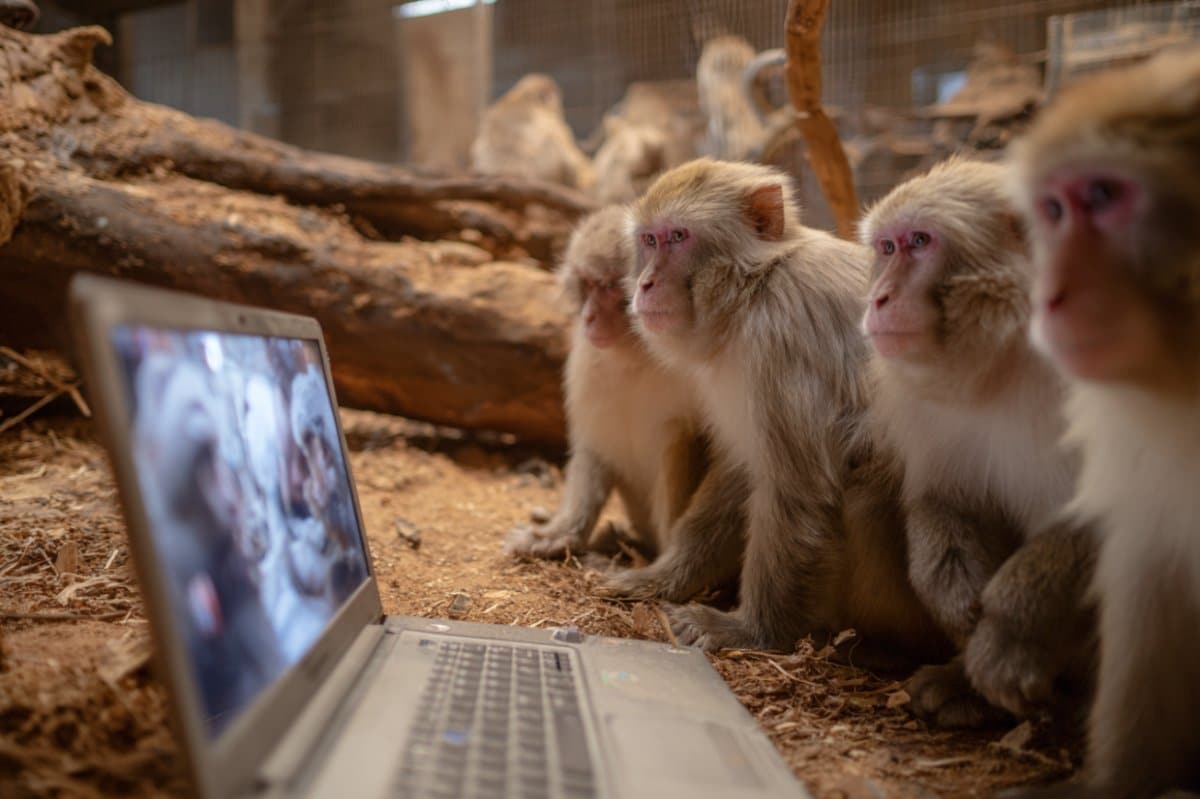Summary: A new study reveals that long-tailed macaques, like humans, are most captivated by videos featuring social conflict and familiar group members. Researchers showed the macaques videos of monkeys engaged in fighting, grooming, running, or sitting, and found they spent the most time watching aggressive encounters.
They also preferred watching members of their own social group over strangers, suggesting a shared evolutionary drive to monitor group dynamics. These findings shed light on the deep social instincts primates share and how personality and status influence attention.
Key facts:
- Conflict Focus: Macaques paid the most attention to videos of aggression.
- Familiar Faces: They preferred watching known group members over strangers.
- Personality Impact: Low-ranking, less aggressive monkeys watched more closely than dominant individuals.
Source: Ohio State University
Have you ever wondered what kind of video content would most grab the attention of monkeys?
A new study of long-tailed macaques suggests the monkeys seem to like some of the same kind of content that humans do: videos featuring aggression and individuals they know.
“Humans and macaques are both social animals who have a fundamental need to belong,” said Brad Bushman, co-author of the study and professor of communication at The Ohio State University.

“It’s not surprising that they both would be most interested in the video content that may help them navigate relationships in their groups.”
The study was published online recently in the journal Animal Cognition. It was led by Elisabeth H.M. Sterck, professor of animal behaviour and cognition at Utrecht University in The Netherlands.
Researchers showed two-minute videos to 28 macaques that lived at a primate research center in The Netherlands. Each macaque saw multiple videos over time featuring monkeys in their group or strangers. Each individual video showed monkeys in one of four types of activities: conflict, grooming of each other, running, or sitting.
The researchers calculated how much time the monkeys spent looking directly at the screen and their reactions while watching.
Findings showed the macaques paid the most attention to videos featuring conflicts between monkeys. Running was the next most popular type of video. Grooming and sitting attracted the least attention.
It is notable that both macaques and humans seem to be attracted to videos featuring similar content, Bushman said.
“We have plenty of research showing the popularity of violent media with humans. Now we have some evidence that other primates might also be attracted to conflict and aggression in videos,” Bushman said.
“From an evolutionary perspective, this makes sense. Both humans and other animals may be hardwired to pay attention to aggression because that is an adaptive response that increases survival,” he added.
The other significant finding of the study was that the macaques watched videos featuring members of their own group more closely than those involving strangers.
“This indicates that gathering social information on group members is more important than getting information about strangers,” Sterck said.
And seeing familiar faces on the screen isn’t just something that’s attractive to monkeys.
“When we as humans watch movies, we like to see actors we know – we like to see the stars playing in big movies more than we do actors who are not familiar to us,” Bushman said.
Findings also showed that low-ranking and less aggressive macaques paid more attention than others to the videos.
“More dominant individuals can be more confident that aggression will not affect them – they don’t have to pay attention to others as much,” Sterck said.
“Lower-ranking individuals can become an aggression victim and that may be why they pay more attention to what others are doing in the videos.”
In addition, high-strung macaques that were more easily stressed paid less attention to group members than those who did not act as stressed.
“We found that the gathering of social information from the videos differed with dominance rank and behavioral tendencies, which may reflect personality,” Sterck said.
The research involved two separate groups of macaques that live at the Biomedical Primate Research Centre in Rijswijk, The Netherlands.
The “stranger” videos that the macaques viewed were those monkeys from a third out-of-view group.
In each enclosure, there is a corridor where the macaques are accustomed to participating in cognitive tests. There were four compartments where the monkeys could watch videos on a laptop. The subjects entered the corridor on their own volition, and were isolated from other monkeys of their multi-generational group during the two-minute videos.
“The macaques are very visual animals. Their eyesight is similar to that of humans and they are very interested in watching videos,” Sterck said.
The researchers said the findings showed that humans share tendencies with our monkey relatives, including the attraction to videos with conflict.
“Even this brief exposure to aggressive media captured the attention of macaques in the study,” Bushman said.
“When you see this in some of our closest primate relatives, it is easy to see why humans are so interested in violent media.”
Other co-authors of the study, all from Utrecht University, were Sophie Kamp, Ive Rouart, Lisette van den Berg, Dian Zijlmans and Tom Roth.
About this animal psychology research news
Author: Jeff Grabmeier
Source: Ohio State University
Contact: Jeff Grabmeier – Ohio State University
Image: The image is credited to Neuroscience News
Original Research: Open access.
“Reactions to social videos in long-tailed macaques” by Elisabeth H.M. Sterck et al. Animal Cognition
Abstract
Reactions to social videos in long-tailed macaques
Animals can obtain important social information by observing social interactions among conspecifics.
Depending on the social content, such as familiarity with the conspecifics and the type of interaction, the receiver’s attention, and possibly also movement and stress response, might differ.
Moreover, these behavioural responses may vary depending on the individual’s own characteristics.
By showing video fragments with different social content (i.e., run, conflict, sit, groom) of group members and strangers, we measured the reaction of captive long-tailed macaques living in multi-generational groups.
In addition, we explored how an individual’s social and self-directed behaviour in its social group was related to reactions to these videos.
Subjects paid more attention to videos of group members than strangers, especially more subordinate and less stress sensitive (i.e., low stress response when observing natural aggression) individuals.
Self-directed behaviour was higher for younger individuals seeing strangers, but not group members, and for individuals with high levels of baseline self-directed behaviour and little grooming.
Regarding context, the monkeys paid more attention to videos with active and aggressive content compared to sitting and grooming videos.
Altogether, monkeys living in multi-generational groups show high interest in gathering social information on group members, and this is modulated by their social role and personal ability to handle social situations.






